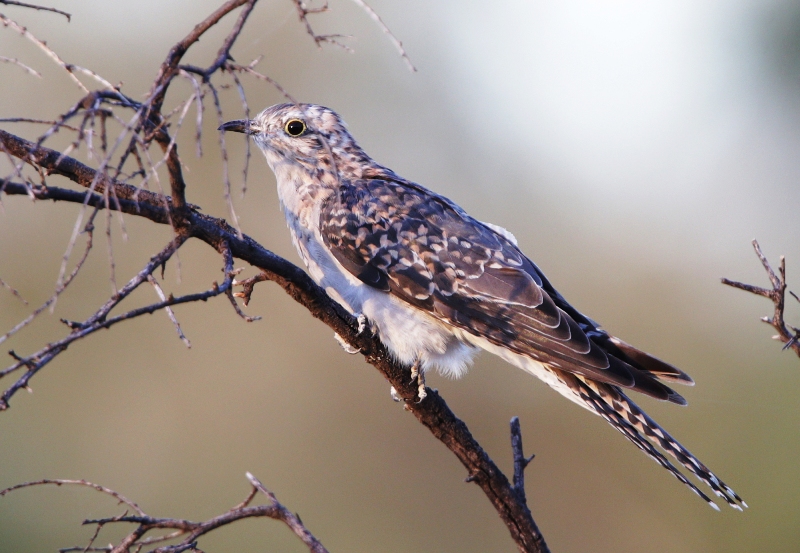At least 80 other species of birds play unwitting host to the egg and young of the Pallid Cuckoo. The most commonly parasitized are honeyeaters of the genus Lichenostomus: yellow-faced, White-plumed, and Singing. Others include miners and Melithreptus honeyeaters, woods wallows, and, less often, thorn-bills, robins, whistlers, and flycatchers.
As with other cuckoos, the nestling ejects the eggs or young of its adoptive parents from the nest. After it has left the nest, its loud squawks for food sometimes induce birds other than its foster parents to feed it. Hairy caterpillars, grasshoppers, and beetles make up the diet of the Pallid Cuckoo, and the hairs from the caterpillars can line its stomach-like fur.
It feeds by sallying, perching still on a vantage point-often dead branch-then diving to the ground to pick up its prey in its bill. Its flight is gracefully undulating, on pointed wings, and it raises its tail erect as it lands. Pallid Cuckoos are solitary birds, frequenting mostly open woodland, and are nomadic, even migrating across southern Australia. There they appear in spring, the males heralding breeding with their loud, rising piping to advertise themselves. Pairing is brief, with males courting females by offering food and peeping softly.
Read More: Chestnut-breasted Cuckoo (Cacomantis castaneiventris)
Pallid Cuckoo is also known as brain/ever-bird, Grasshopper Hawk, Harbinger of Spring, Mosquito Hawk, Rain-bird, Scale-bird, or Semitone- Bird. Pallid Cuckoo is about 290–330 mm in length. The male cuckoo Upper parts are rich mid-gray when fresh, becoming brownish with wear and a white spot on the nape.
Face with a dusky line through the eye. The underparts are uniformly pale gray. The wings and shoulders are mid-grey with a white patch on the leading edge near the shoulder; the inner webs of primaries have white tooth-like spots, forming bars.
The upper side of the tail is dusky black, becoming brown with wear, with white or buff tooth marks on the outer webs and broad white tooth marks on the inner webs. Eyes are dark brown, with yellow eye rings; however, the upper bill is dark brown, and the lower is dark olive-brown. Feet pale olive-brown; claws duskier.
The female cuckoo is like the male; it is browner and faintly mottled on the upper parts. The juvenile cuckoo is strongly streaked dark brown and white, with white edges and tips to wing feathers. Immatures have upper parts heavily mottled with chestnut and dark brown; underparts pale grey; breast buff with dark brown bars, later replaced by uniform grey, with a few dark brown and chestnut feathers on the side.
Related Reading: Common Hawk-cuckoo Call

The pallid cuckoo call is a loud, melancholy whistling note by a male rising up the scale in chromatic sequence, the second note is often lower than the first. Also hysterical crookyer, in pursuit of female; staccato pip-pip-pip-pip. The female has a harsh single call. The male pallid cuckoo often calls at night, like other cuckoos. The breeding and nesting seasons are September-January.
Normally the nest contains one egg: flesh-pink to salmon-buff, sometimes with a few small scattered dark specks; long-oval, about 26 x 19 mm. Laid in an open cup nest of another species; probably several nests parasitized by the same female each year.
The Pallid Cuckoo is found throughout Australia in all types of open vegetation, least often in rainforests. Partial migrants move north and inland in winter; they are present all year round. Mainly juveniles remain over summer in the far south. Some birds reach the Moluccas, New Guinea, and Timar on non-breeding migration.
Read More: The Striking Squirrel Cuckoo
